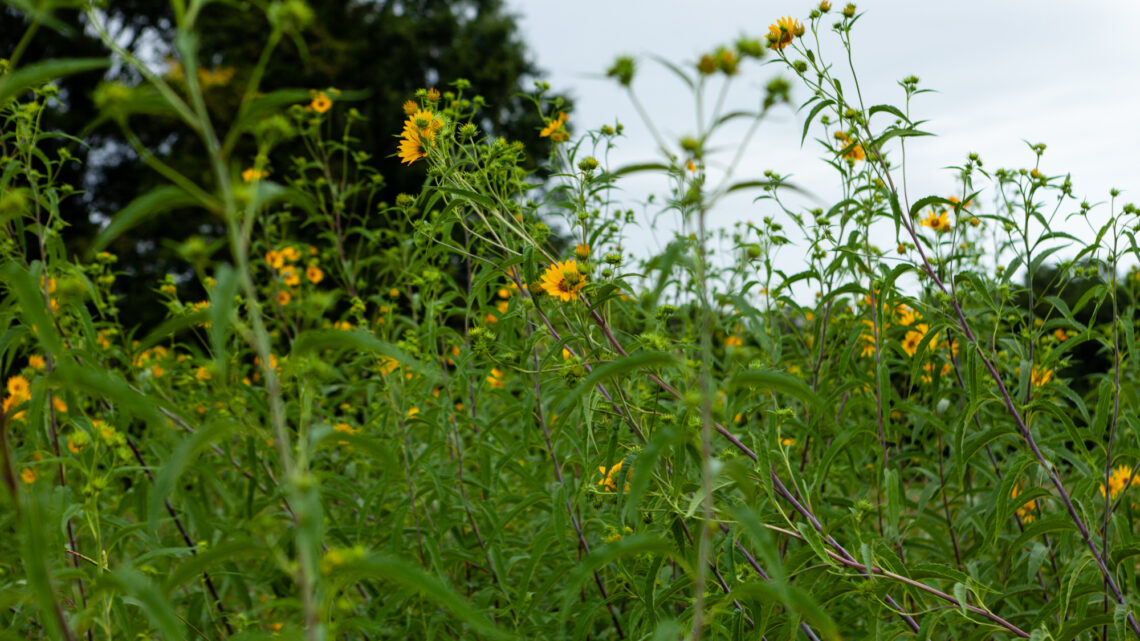Meadows

Meadows provide shelter and food for a variety of wildlife that live within the Mid Atlantic region. Meadows are composed primarily of herbaceous or non-woody plant species. Their open structure and flowering plants attract mammals, birds, and pollinators.
Meadows can serve as an agricultural buffer by preventing sediment and nutrients from reaching waterways. Meadows can also improve water quality by cleaning runoff in suburban and rural areas by using them in place of traditional lawns. A school, home or park can install a meadow in a grassy area by restricting or stopping mowing. The land will go through stages of succession and can be helped along by first removing the turf and adding seeds or plants.
Connecting to Issue Investigation
The variety of environmental benefits a meadow provides can make this solution relevant to many different investigations. For example, if during the course of an investigation or school audit, students see a need for protecting or improving wildlife habitat, decreasing impervious surfaces, cleaning runoff, or the environmental benefits of decreasing manicured lawn then a meadow can help! In addition, a school or nearby meadow can provide a fascinating outdoor laboratory and location for outdoor learning across many disciplines.
For those working towards green school awards, this action can reduce a school’s environmental impact if the meadow is located on school grounds.
Facilitating Student Action
Students should continue to have opportunities to share ideas and opinions throughout the process of identifying, planning, and implementing action. Listed here are just a few ways students can stay engaged while working on this solution—but there are many more! The complexity of each activity/task can be adjusted for each grade level.
Protect - students can educate others on why meadows should be protected. Younger students can create simple scripts to deliver to decision makers and land owners and older students can create more involved presentations that include primary sources.
Restore - students can work on restoring a local meadow. Using age-appropriate resources, students can identify invasive plants, remove them, and suggest replacements to improve the habitat.
Create - students can create a meadow on the schoolyard or in the community. Depending on age, students can help with or lead the initial steps of determining if a meadow would thrive in a place by measuring the soil and precipitation. Students can research the components of a healthy meadow and get involved with plant selection, habitat design, and installation. Meadows take years to establish so student’s work may just focus on initial planning and setting up a multiyear maintenance plan.
Monitor - students can monitor a new or established meadow. Monitoring protocols will differ by age. Results and observations can be shared with others to encourage protection or inform restoration. Data sets can build up over years and students can track changes in the habitat.
Share and Celebrate - students can share their work with the school community by giving tours of the meadow, giving presentations, creating displays, or writing and delivering morning announcements. Students can also write articles, press releases or invite reporters from the school paper and the local newspaper.
Meadow Resources
U.S. Fish & Wildlife Service’s Schoolyard Habitat Project Guide is a comprehensive guide that walks you through the entire process of creating or restoring a schoolyard habitat or outdoor classroom space. The information is transferable to habitats outside schoolyards. See Appendix B of the guide for meadow-specific instructions. The guide also includes ideas for monitoring and sharing the wetland.
The Mid-Atlantic Native Meadows Guidelines for Planning, Preparation, Design, Installation and Maintenance provides a more detailed guide on how to create a healthy meadow.
Creating a Wild Backyard - Wildflower Meadows from Maryland Department of Natural Resources provides a simple step-by-step guide to installing a meadow and includes a list of plant species for wet and dry meadows.
